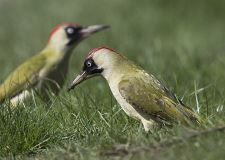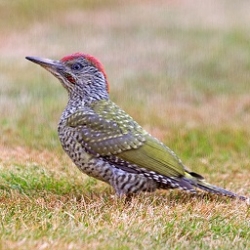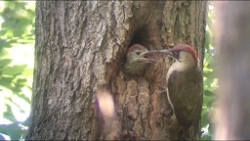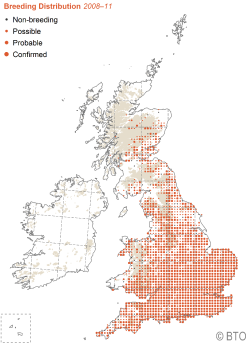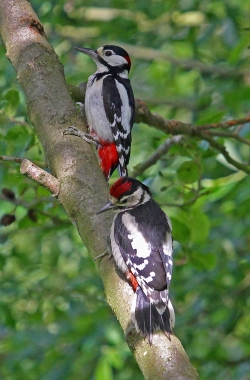Green Woodpeckers (Picus viridis) are the largest of our three woodpeckers and are resident and common in England, Wales and parts of Scotland. They are not present in Ireland.
We will use these pages to report some current and past observations and studies of these fascinating birds.
Green Woodpeckers are gorgeous with their vivid green and yellow plumage, a striking red crown and black face mask. At 31-35cm (12.0-13.8 ins) long from bill tip to tail tip and weighing around 190g (6.7oz) they are about the size of a Jackdaw. They are often seen feeding on grassy areas.
Young Green Woodpeckers look different, they are heavily scaled and spotted black and white without the black face, see photos on left.
In 2016 the British Trust for Ornithology (BTO) estimated there were 46,000 pairs in Britain (with a range of 41,000-51,000).
The map shows the breeding distribution from the latest BTO Atlas (2008-11). Comparison with previous atlases showed a decrease in numbers in southwest England and Wales and increases in the east – more than doubling in 16 years.
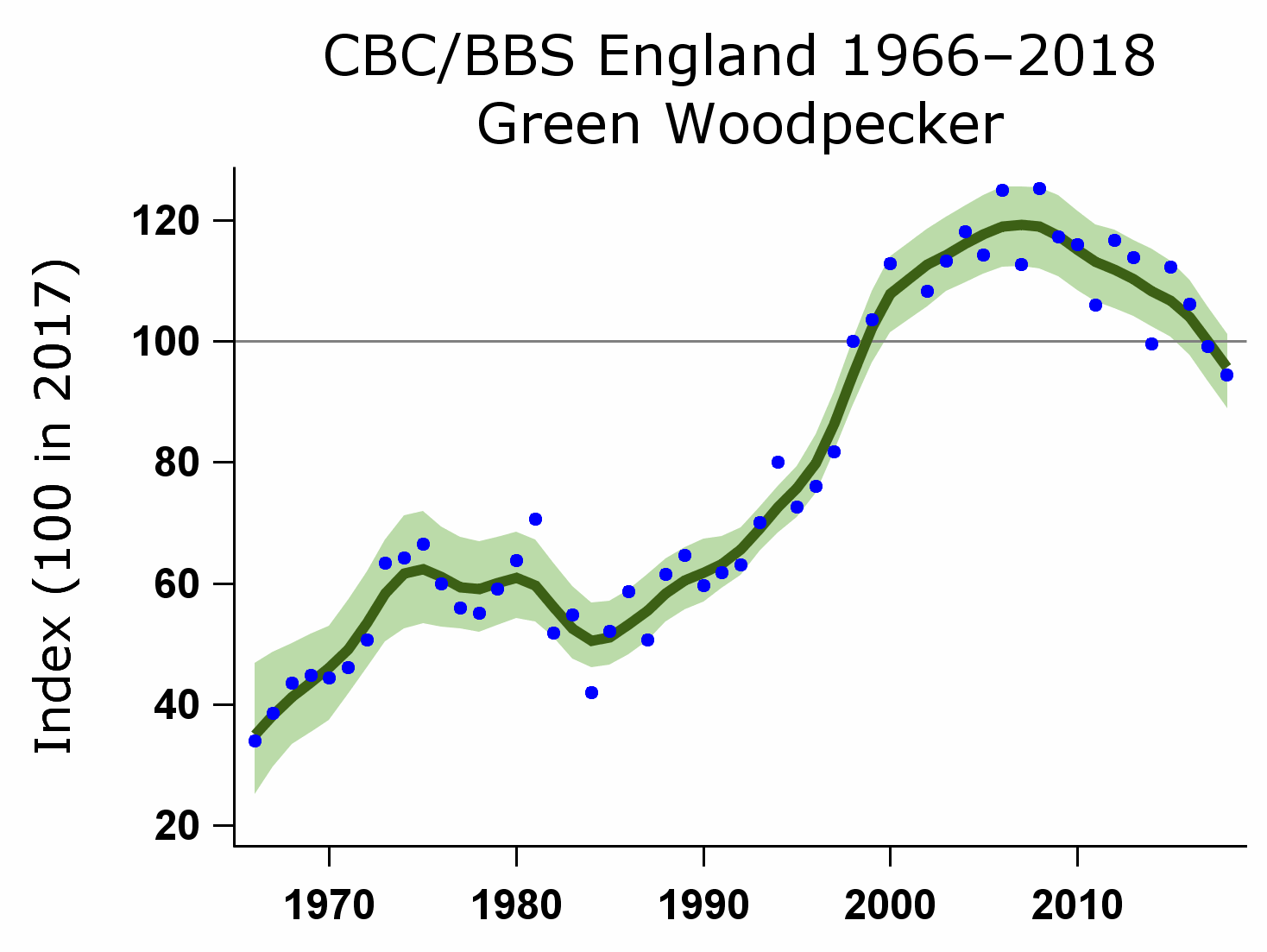 Green Woodpecker index from BTO Breeding Bird Survey from 1966 to 2018. The index is set at 100 for 2017The chart shows breeding population index from 1966-2017 derived from Common Bird Census/Breeding Bird Survey data (BTO/JNCC/RSPB Breeding Bird Survey. Bird Trends Report). This increased steadily until 2006 but now shows a gradual decline after a peak in 2008.
Green Woodpecker index from BTO Breeding Bird Survey from 1966 to 2018. The index is set at 100 for 2017The chart shows breeding population index from 1966-2017 derived from Common Bird Census/Breeding Bird Survey data (BTO/JNCC/RSPB Breeding Bird Survey. Bird Trends Report). This increased steadily until 2006 but now shows a gradual decline after a peak in 2008.
Green Woodpeckers are basically sedentary and do not move far from year to year. Information from the BTO ringing scheme shows that the median recovery-distance for adults is 1km and for juveniles is 3km. The longest movement recorded by BTO ringing is 71km, during the harsh winter weather of early 1963.
Green Woodpeckers nest in cavities in trees which they excavate themselves. They have one brood per year with a clutch of 4-6 eggs each weighing about 9g. The incubation period is 19-20 days with fledging after 21-24 days. They are long lived the record being 15 years.
About 300 birds are ringed each year.
For more information see BTO bird facts on Green Woodpecker
In 2020 two Woodpecker Network volunteers took the initiative to record nesting woodpeckers in their local area in Norfolk, whilst compying with COVID-19 restrictions. Ricky tells the story ...
GREEN WOODPECKER NESTS: SOUTH NORWICH-2020
By Ricky Cleverley
Looking for Woodpecker Nests - A Local Initiative
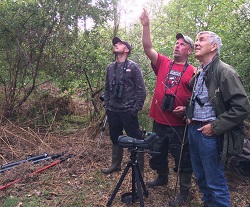 Ricky and Mat with Ken in discussion about woodpecker nest in 2019By the time Spring 2020 finally arrives local birder, Matthew Shore, and I would have usually been heading off to some suitable habitat to go listen out for the sound of drumming Lesser Spotted Woodpeckers. But as March was in full swing, we were all hit by the coronavirus crisis and were forced into a national lockdown which went into April and May. This meant we were unable to go looking for Lesser Spots, so Mat and I agreed to turn our efforts to finding local woodpecker nests.
Ricky and Mat with Ken in discussion about woodpecker nest in 2019By the time Spring 2020 finally arrives local birder, Matthew Shore, and I would have usually been heading off to some suitable habitat to go listen out for the sound of drumming Lesser Spotted Woodpeckers. But as March was in full swing, we were all hit by the coronavirus crisis and were forced into a national lockdown which went into April and May. This meant we were unable to go looking for Lesser Spots, so Mat and I agreed to turn our efforts to finding local woodpecker nests.
The Lesser Spotted Woodpecker is a rare breeding bird in Norfolk and with us living in the Norwich area we were sure we wouldn’t be hearing any calls or drumming from them. But of course the Great Spotted and Green Woodpeckers would definitely be a good target and only a walk or bike ride away.
So after discussions with Ken and Linda Smith from the LesserSpotNetwork Science Project, who have many years of experience between them as regards all things Woodpeckers, we agreed to try find as many nests local to us of those two species.
Mat and I both had experience of observing the species from the previous years, so we set to work on trying to locate suitable habitat for both species around where we lived or worked.
Looking for Green Woodpecker Nests Green Woodpecker nests aren't as easy as finding a Great Spotted Woodpecker nests and after speaking to Ken Smith, he confirmed this by telling us there were only a handful of Green Woodpecker nests found and reported to the BTO Nest Records each year!
I was now back to work, as the month of May approached and as my job takes me around the city’s outskirts, I began to listen out for any ‘yaffling’ of a Green Woodpecker as I worked.
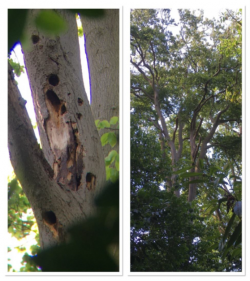 The 'Master' Beech tree, well used by Green Woodpeckers over the yearsWhile working at a school south of Norwich I was pleased to hear on two mornings a Green yaffling from the edge of a suitable woodland area. The school playing field which sat between the wood and school was a suitable food source so I decided to use my lunch break to investigate. After two visits to the wood and hearing a pair call to one another I found what we call a “Master Tree”, a tree which has a number of woodpecker holes in it. Some just a start of a hole (pilot) or some excavated fully or some in the process of being done. These holes on a species of Beech were all clearly Green Woodpeckers from the size of the hole and so I decided to return the next day at lunch and stake it out.
The 'Master' Beech tree, well used by Green Woodpeckers over the yearsWhile working at a school south of Norwich I was pleased to hear on two mornings a Green yaffling from the edge of a suitable woodland area. The school playing field which sat between the wood and school was a suitable food source so I decided to use my lunch break to investigate. After two visits to the wood and hearing a pair call to one another I found what we call a “Master Tree”, a tree which has a number of woodpecker holes in it. Some just a start of a hole (pilot) or some excavated fully or some in the process of being done. These holes on a species of Beech were all clearly Green Woodpeckers from the size of the hole and so I decided to return the next day at lunch and stake it out.
Well, I’m glad I did as I witnessed a bird arrive and begin to go inside fully and start to remove small amount of wood chips, this was a potential nest hole for sure! Checking the base of the tree itself revealed a massive amount of wood chips scattered around the ground, showing me just how much of a cavity the bird had already excavated inside the hole! I think I had just caught the nest a few days before egg laying and the next time i visited, I witnessed a change over at the nest, confirming they were incubating - magic!
Meanwhile Mat had also been busy by searching some nearby habitat to where he lived and he also had found a Green Woodpecker nest in an Ash tree. This one was interesting as it was a hole inside a natural cavity and nice looking hole to observe.
Over the coming weeks we spent many hours walking /searching woods and areas of suitable trees, with good feeding habitat nearby and found a total of nine nests, all of which we would go on to observe!
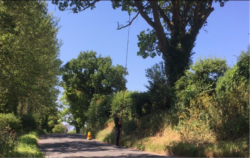 The picture shows me using the nest inspection camera & pole set up, that was used to collect the data from the nests.In late May the Covid restrictions were eased. We used a nest inspection camera, borrowed from Ken and Linda Smith, to look inside the nest cavity and see the number of eggs or young and monitor their progress.
The picture shows me using the nest inspection camera & pole set up, that was used to collect the data from the nests.In late May the Covid restrictions were eased. We used a nest inspection camera, borrowed from Ken and Linda Smith, to look inside the nest cavity and see the number of eggs or young and monitor their progress.
We always set out to make observations for one hour at each visit to a nest and record the following data throughout the months of observations:
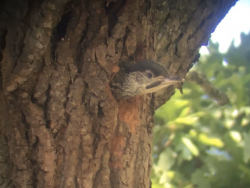 Green Woodpecker chick looking out•Location
Green Woodpecker chick looking out•Location
•Date nest was found
•What stage the nest was at
•Height of Hole
•Direction the hole was facing
•Tree Species
•Number of young hatched
•Number of young fledged
•The fledge date
•Total number of visits/observations.
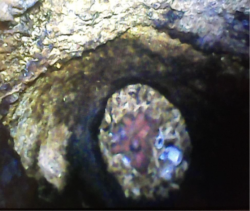 Nest BBW4, the nest inspection camera shows five tiny chicks, just hatched, some of the eggs shells are still on the side A special nest - BBW-4 - We found this nest on 30th May and we inspected the nest that same day, using the camera which revealed 5 recently hatched eggs, in fact they literally had just hatched in the past few hours. This was great as we were able mark this date down as hatch date and would therefore be able to work out the exact age of the young when they fledged.
Nest BBW4, the nest inspection camera shows five tiny chicks, just hatched, some of the eggs shells are still on the side A special nest - BBW-4 - We found this nest on 30th May and we inspected the nest that same day, using the camera which revealed 5 recently hatched eggs, in fact they literally had just hatched in the past few hours. This was great as we were able mark this date down as hatch date and would therefore be able to work out the exact age of the young when they fledged.
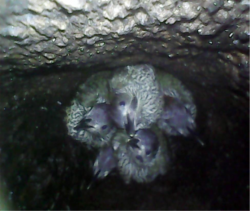 Five Green Woodpecker chicks in nest GM7 on 13 June 2020, they fledged 3 days laterAlso these pictures were a great help for us as regards working out how old other young are in the nests when using the inspection camera.
Five Green Woodpecker chicks in nest GM7 on 13 June 2020, they fledged 3 days laterAlso these pictures were a great help for us as regards working out how old other young are in the nests when using the inspection camera.
Using the Breeding Nest info from BTO* we know they incubate the eggs for around 19 -20 days, putting the egg laying date around the 12th April. Then the fledge date being between 21-24 days.
The following breeding dates therefore are-
- Egg laying date: 12-4-20
- Hatch date: 30-5-20
- Fledge date: 23-6-20
Therefore the young fledged at 25 days old. We used this information to estimate the egg laying date for all our nests.
*BTO website https://app.bto.org/birdfacts/results/bob8560.htm
Results
We monitored nine nests. One (AT3) failed at the egg stage. Young fledged successfully from eight nests (89% success), at least 35 young fledged, an average of 4.4 chicks per successful nest.
The information gathered is shown in the table.
Our nine nest records in 2020 are more than the five reported nationally in 2016 !
|
Nest code |
visits to nest (camera) |
First egg date* |
No. of young hatched |
No. of young fledged |
Fledge date |
|
ECO1 |
15(2) |
22-5-20 |
3 |
3 |
15-6-20 |
|
WW2 |
16(1) |
20-5-20 |
5 |
5 |
13-6-20 |
|
AT3 |
6(2) |
15-5-20 |
0 |
0 |
0 |
|
BBW4 |
9(3) |
30-6-20 |
5 |
5 |
23-6-20 |
|
AW5 |
6(2) |
29-5-20 |
6 |
6 |
21-6-20 |
|
HC6 |
4(1) |
14-5-20 |
6 |
6 |
7-6-20 |
|
GM7 |
4(1) |
23-5-20 |
5 |
5 |
16-6-20 |
|
GM8 |
3(1) |
24-5-20 |
4/5 |
4/5 |
17-6-20 |
|
SS9 |
2(1) |
30-5-20 |
? |
1 + |
23-6-20 |
Other Observations
A number of other potential nests were also found either by me or Mat. We observed young feeding/ calling or saw adults in trees with suitable holes at eight other sites. So our conclusion is that Green Woodpeckers are thriving in our part of Norfolk.
We also found and monitored 12 Great Spotted Woodpecker nests and to top it all, two Lesser Spotted Woodpecker nests - quite a year.
